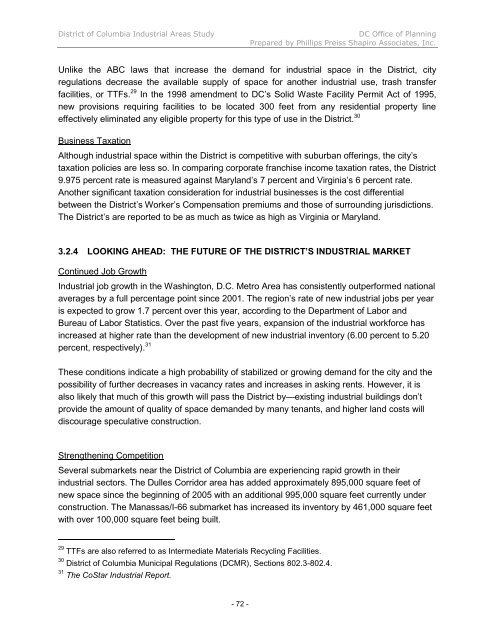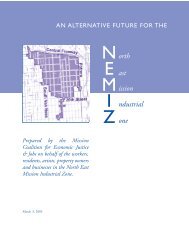INDUSTRIAL LAND IN A POST-INDUSTRIAL CITY District of ...
INDUSTRIAL LAND IN A POST-INDUSTRIAL CITY District of ...
INDUSTRIAL LAND IN A POST-INDUSTRIAL CITY District of ...
You also want an ePaper? Increase the reach of your titles
YUMPU automatically turns print PDFs into web optimized ePapers that Google loves.
<strong>District</strong> <strong>of</strong> Columbia Industrial Areas Study DC Office <strong>of</strong> Planning<br />
Prepared by Phillips Preiss Shapiro Associates, Inc.<br />
Unlike the ABC laws that increase the demand for industrial space in the <strong>District</strong>, city<br />
regulations decrease the available supply <strong>of</strong> space for another industrial use, trash transfer<br />
facilities, or TTFs. 29 In the 1998 amendment to DC’s Solid Waste Facility Permit Act <strong>of</strong> 1995,<br />
new provisions requiring facilities to be located 300 feet from any residential property line<br />
effectively eliminated any eligible property for this type <strong>of</strong> use in the <strong>District</strong>. 30<br />
Business Taxation<br />
Although industrial space within the <strong>District</strong> is competitive with suburban <strong>of</strong>ferings, the city’s<br />
taxation policies are less so. In comparing corporate franchise income taxation rates, the <strong>District</strong><br />
9.975 percent rate is measured against Maryland’s 7 percent and Virginia’s 6 percent rate.<br />
Another significant taxation consideration for industrial businesses is the cost differential<br />
between the <strong>District</strong>’s Worker’s Compensation premiums and those <strong>of</strong> surrounding jurisdictions.<br />
The <strong>District</strong>’s are reported to be as much as twice as high as Virginia or Maryland.<br />
3.2.4 LOOK<strong>IN</strong>G AHEAD: THE FUTURE OF THE DISTRICT’S <strong><strong>IN</strong>DUSTRIAL</strong> MARKET<br />
Continued Job Growth<br />
Industrial job growth in the Washington, D.C. Metro Area has consistently outperformed national<br />
averages by a full percentage point since 2001. The region’s rate <strong>of</strong> new industrial jobs per year<br />
is expected to grow 1.7 percent over this year, according to the Department <strong>of</strong> Labor and<br />
Bureau <strong>of</strong> Labor Statistics. Over the past five years, expansion <strong>of</strong> the industrial workforce has<br />
increased at higher rate than the development <strong>of</strong> new industrial inventory (6.00 percent to 5.20<br />
percent, respectively). 31<br />
These conditions indicate a high probability <strong>of</strong> stabilized or growing demand for the city and the<br />
possibility <strong>of</strong> further decreases in vacancy rates and increases in asking rents. However, it is<br />
also likely that much <strong>of</strong> this growth will pass the <strong>District</strong> by—existing industrial buildings don’t<br />
provide the amount <strong>of</strong> quality <strong>of</strong> space demanded by many tenants, and higher land costs will<br />
discourage speculative construction.<br />
Strengthening Competition<br />
Several submarkets near the <strong>District</strong> <strong>of</strong> Columbia are experiencing rapid growth in their<br />
industrial sectors. The Dulles Corridor area has added approximately 895,000 square feet <strong>of</strong><br />
new space since the beginning <strong>of</strong> 2005 with an additional 995,000 square feet currently under<br />
construction. The Manassas/I-66 submarket has increased its inventory by 461,000 square feet<br />
with over 100,000 square feet being built.<br />
29 TTFs are also referred to as Intermediate Materials Recycling Facilities.<br />
30 <strong>District</strong> <strong>of</strong> Columbia Municipal Regulations (DCMR), Sections 802.3-802.4.<br />
31 The CoStar Industrial Report.<br />
- 72 -












